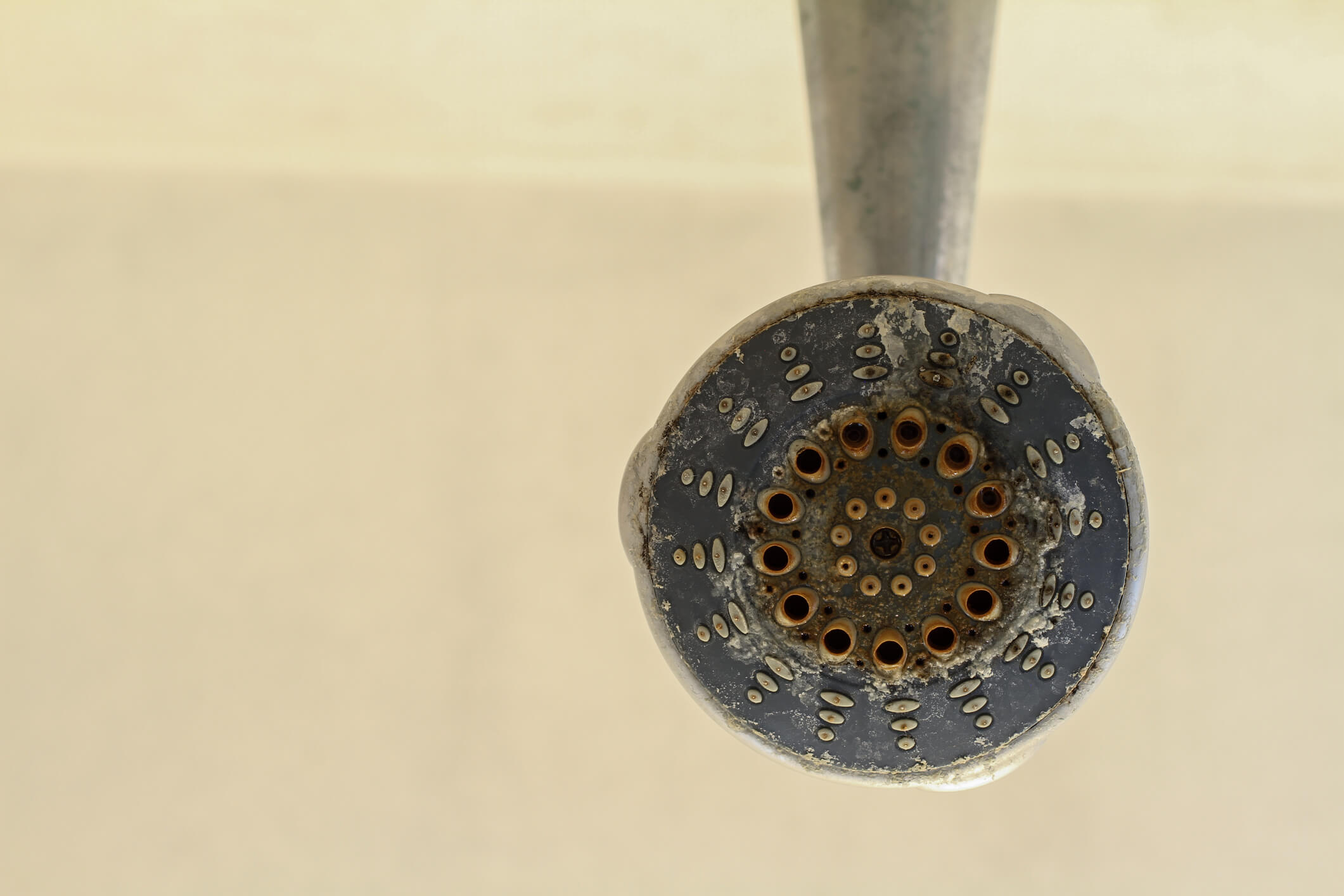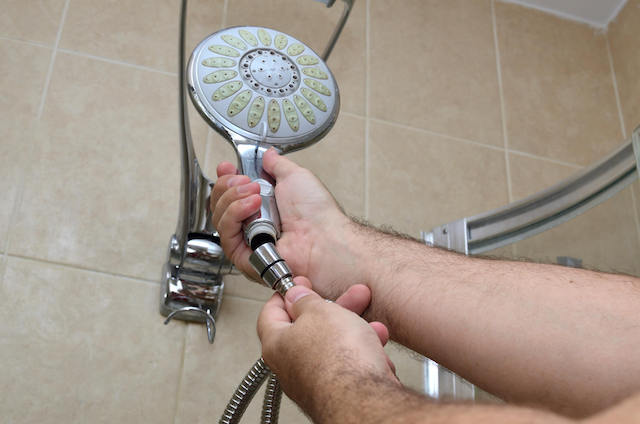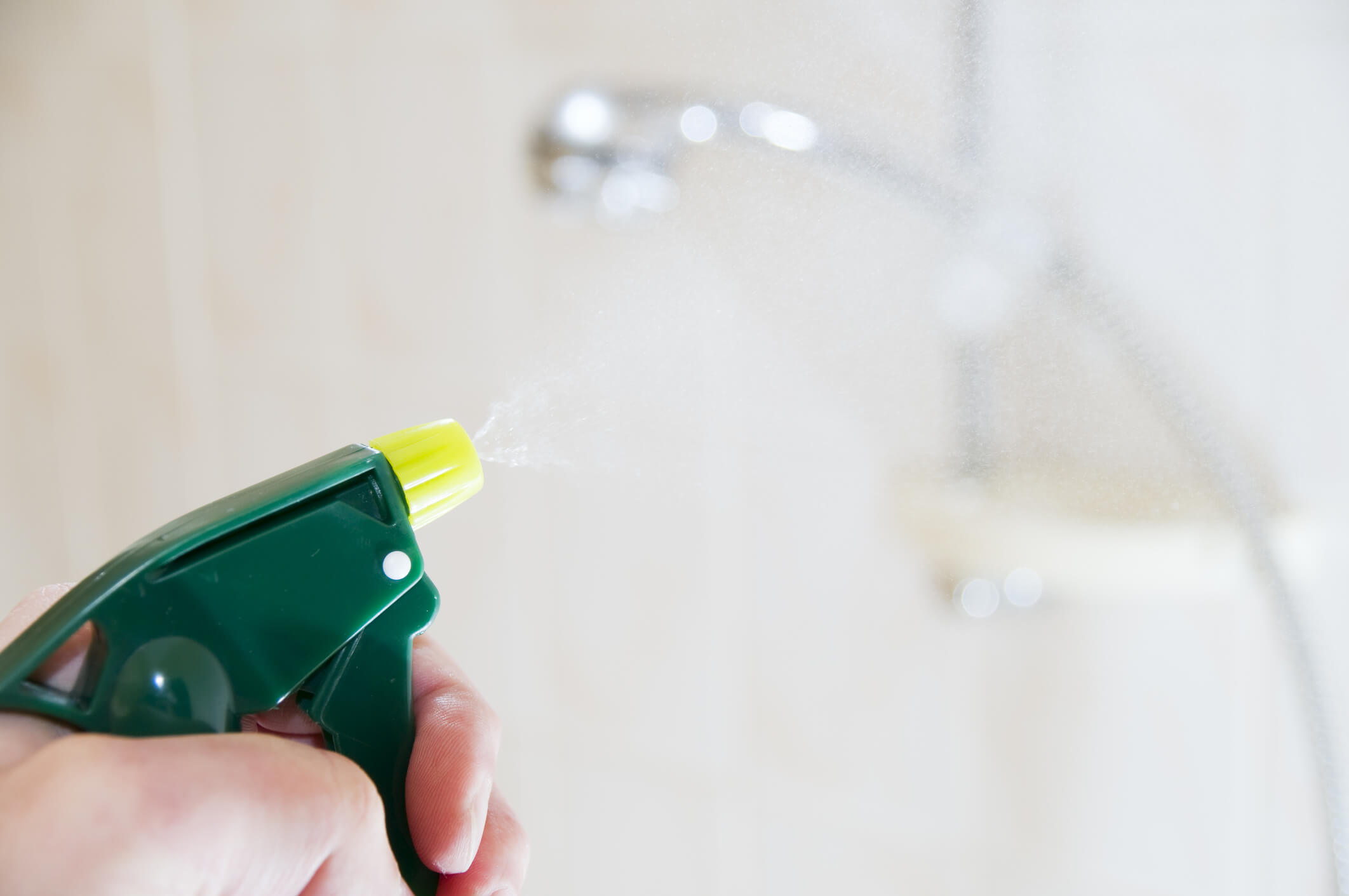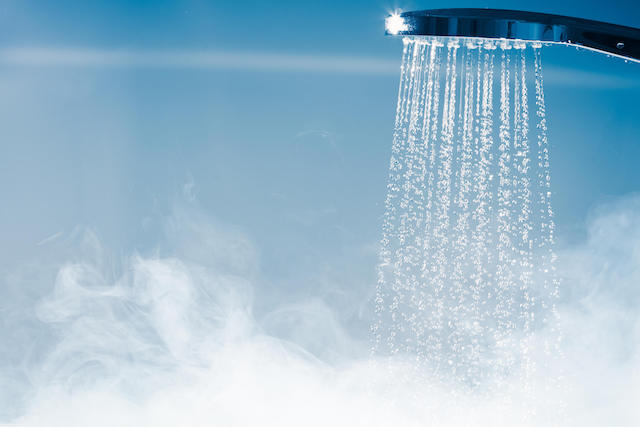There you are, peacefully going about your regularly scheduled shower program when you realize that the water isn’t coming out at full blast. Instead, it’s a wonky trickle with one little stream of water veering way off to the left. Then you start eyeing the source of the rain on your parade and... is that a moldy shower head?

Gross! Just think about all of those particles raining down on you while you’re trying to get some R&R time or start your day on a clean foot. That’s probably not exactly the refreshing experience you were going for.
But this happens all the time to people across the world. These fixtures are actually perfect homes for not only mold but also other microorganisms like bacteria. The good news is that, with a little TLC, a moldy shower head won’t funk up your bathroom routine.
Here's what you need to know.
How Does a Moldy Shower Head Even Happen?
Before getting into the do’s and don’t’s of maintenance, you’ve got to know what it is you're fighting and why these pesky indoor contaminants love that shower head.
Mold Fast Facts
Mold is a type of fungus with over 100,000 species identified so far. Each species reproduces by creating non-living microscopic particles called spores and releasing them into the surrounding environment.¹’² Like seeds, these particles will remain spores until they stumble upon a surface with the ingredients they need for life.
In the case of mold, spores only need two main components to transition into a living colony.³
These two elements are:
- Food
- Moisture
If a spore lands on a surface that has a food and moisture source for 24–48 hours, it will put down roots called hyphae and colonize the space. This is a key detail to remember and why remediating mold is a pain. Like a weed, you’ve got to remove mold by the root; otherwise, it will grow right back.
Once it’s settled down for the long haul, the colony will start up that reproductive cycle and begin pumping spores into the environment. Some species of mold also produce microscopic toxins called mycotoxins, adding to that particle party.⁴ Because these tiny toxins are toxic to the human body, they’re regulated in our food but, oddly enough, not in our indoor environments.
And not to be outdone, it just so happens that bacteria often thrive in the exact same environment. So where there’s mold, bacteria often tag along for the ride, releasing even more particles into the surrounding environment.
Adding in the Moldy Shower Head Component
Now picture your shower head. Whether you have a run-of-the-mill fixture or one with a ton of fancy gadgets, they can all provide a nice little home for that fungus among us.
Water? Seeing as how their job is to continually spray that H2O to help you get clean, this is an easy checkmark for a moldy dream home. Not to mention, the high humidity often created by steamy showers or baths can also provide enough moisture for a colony to grow.
As for food, there are a couple of options that can help mold grow. The water itself can contain organic particles and create mineral buildup, both of which can offer an edible buffet for a moldy colony. Tiny particles floating throughout the air, such as skin cells or bath products, can also stick to the shower head as well.
Before you know it, a moldy shower head is raining down all sorts of indoor contaminants on your head, which is a health hazard no-no.

A Moldy Shower Head Wellness Concern
The key factor to consider here is that all of the particles produced by the microorganisms holing up in your shower head are microscopic. They’re so tiny that they’re measured in a unit called micron, which is 1/1000th of a millimeter (those tiny lines on a ruler). The EPA further classifies them as particulate matter and breaks them down into categories.⁵
These two categories are:
- PM10: particles that have a diameter of around 10 micrometers or less.
- PM2.5: fine particles that have a diameter of around 2.5 micrometers or less.
The big deal with their size is that they’re small enough to be inhaled, ingested, and absorbed into the body.⁶ Some of the particles are so small that they can zip straight into your bloodstream. Obviously, a bunch of foreign particles isn’t a great thing for the body, which is why they’re a health concern.
That being said, it’s impossible to completely avoid encountering mold spores, mycotoxins, and bacteria throughout the day. Thanks to our handy dandy immune system, the body is equipped to kick them out in this situation. Full-on blasting yourself with contaminants from a moldy shower head isn’t exactly the same scenario, though.
Instead of a couple of particles throughout the day, your body is now at war with a high volume of particles entering the body every time you step into the bathroom and shower. It will try to keep up, but the immune system can get bogged down and/or malfunction, leading to a long list of possible chronic symptoms.⁷’⁸’⁹’¹⁰’¹¹

A few common symptoms of exposure include:
- Hormonal imbalances
- Hair loss
- Rashes
- Brain fog
- Chronic fatigue
- Digestive issues
- Runny nose
- Coughing
- Muscle and joint pain
The interesting and difficult thing, though, is that no two people respond the same way to exposure. One person using a moldy shower head may have the occasional sinus infection while another develops a dozen symptoms. You just never know how your body will react.
Much more research is needed to better understand this little-discussed issue, but it’s a difficult problem to assess. Various factors play a role in whether or not a person will feel the effects of exposure. A few of these include genetics, species of mold, presence of mycotoxins, presence of bacteria, and volume of exposure. All of which come together to create a question mark over how a moldy shower head will affect you and your loved ones.
The potential for health concerns is reason enough to prevent this contaminant-filled disaster from happening to you. Plus, showering in mold is pretty up there on the icky scale.
How to Prevent a Moldy Shower Head
The best way to tackle a moldy shower head is to say, "Not in my house," and avoid it from occurring in the first place. Your main goal will be to remove the elements needed for mold and bacteria to grow and ensure your fixture is operating properly.
The top route to prevent a moldy shower head is to deep clean it at least once a month. This will help remove any mineral buildup that can be used as a food source, as well as any contaminants that managed to sneak inside. If you live in a hard water area, it should be cleaned even more frequently because of all the additional minerals and dissolved solids being pumped out.
Since all shower heads are different, make sure to read the manufacturer’s instructions before beginning to see their recommendations on the best way to deep clean your fixture.
That being said, deep cleaning your shower head should generally include:
- Grabbing a wrench and carefully disconnecting the fixture.
- Removing any plumbing tape from the arm.
- Assessing the small screen right inside where the water enters the fixture. If it’s clogged, grab a pair of needle nose pliers to gently remove it from the fixture and rinse it under warm water.
- Turning the shower head nozzle side up and soaking it in a bowl of 1:1 white vinegar and water. If you removed the small screen, this should be soaked in the solution as well.

- Allowing it to sit throughout the day or overnight.
- Rinsing the screen and head with hot water.
- Wiping the shower head with a microfiber towel. These are 100 times better at wiping away microscopic particles than regular rags.
- Replacing the screen where it belongs.
- Wrapping new plumbing tape around the threads of the shower arm to help prevent water leakage.
- Reinstalling the shower head on the wall.
- Running hot water through the head for several minutes to rinse away any grime inside the nozzles.
If you can’t remove the shower head from the wall, a good trick is to fill a baggy full of 1:1 white vinegar and water, grab a few rubber bands, and tie it to the arm of the fixture. It can be a bit of a pain, but it will help eliminate mineral buildup in the head.
One thing you should absolutely avoid in your cleaning routine is harsh chemicals like bleach. These products will not help lift particles from the surface so that they can be removed, will lead to you showering with those harsh chemicals, and can damage your shower head. Any of which is a no-go for your maintenance routine.
A few other steps to prevent a moldy shower head include:
- Maintaining indoor humidity between 35 and 50%¹²: High humidity can lead to mold growth, so keep this level low. Focus on creating bathroom airflow, investing in a dehumidifier, hanging up towels and bathmats to dry, and wiping up any pooled liquid.
- Installing an inline shower head filter: This will help reduce mineral deposits in your shower head, helping to present growth.
- Do a daily wipe-down: Spray a botanical cleaner like Benefect Decon 30 or a mixture of white vinegar and water on the shower head after use, allow it to sit for 30 seconds, and then wipe with a microfiber towel. Make sure to turn the water on before hopping back in the next day so that any remaining particles are washed away.
- Replace the shower head on time: Shower heads should be replaced every 6-8 months to avoid pesky contaminant growth. With proper maintenance and cleaning, this shelf-life can be extended even longer. Just make sure to pay close attention to any wear and tear that can cause issues.

Collectively, this will help make sure that a moldy shower head doesn’t muck up your cleanliness.
How to Clean a Moldy Shower Head
Even with all of this prevention, a moldy shower head can still pop up in your home. These indoor contaminants are just pesky that way.
If you’re staring up at a contaminated fixture, the absolute best way to handle the situation is to remove the head, deep clean the surrounding area to remove any particles produced by the mold colony, and then replace it with a new one. It may seem extreme, but with all of the tiny holes, cracks, and crevices in the shower head, it can be nearly impossible to totally eliminate all of the particles stuck inside.
Any particles left behind lead to continued exposure, allowing for chronic symptoms to develop and/or persist. Not to mention, it can easily lead to mold growing right back.
For hypersensitive individuals, this should absolutely be the standard to follow.
If you don’t want to part with your shower head, you can attempt to deep clean the fixture using the steps above, but keep a close eye on it once you’re finished. If the mold grows right back or you start to develop a random assortment of symptoms, it’s time to throw that moldy shower head in the garbage and start fresh.
How Do You Know If You Have a Moldy Shower Head?
Figuring out if there’s a problem can be a bit tricky thanks to all of the hidden spaces in the shower head for colonies to grow. That being said, here’s what you should do.
Take a Close Look
Remove the fixture from the wall, grab a flashlight, and look closely at any accessible area on the shower head, especially the tiny nozzles.
With so many species existing in the world, mold colonies can come in a variety of colors, shapes, and textures. Some of the most common colors include green, white, grey, blue, red, black, brown, or a combination of them. As for textures, they could be fuzzy, powdery, velvety, or slimy.
If any type of unidentifiable growth pops up in the shower head, it's safe to assume there’s a mold problem and the fixture needs to be replaced.

Give it a Sniff
Mold growth isn’t always visible. It could be in a hidden area in the fixture like the nozzles, or the colony is too small to be visible to the naked eye yet. In this instance, look to your nose to help determine if there’s a problem.
Growing mold often creates an earthy, musty, damp smell due to the release of gases called microbial volatile organic compounds (MVOC).¹³ If this odor is coming from the shower head, it points to a problem existing inside.
Do You Feel Okay?
Neither of those boxes is checked off, but do you still suspect a problem? First of all, always listen to your intuition! When it comes to indoor mold growth, instinct is a powerful tool to ensure our indoor spaces are safe and promote healthy living.
Our bodies are amazing warning systems that will let us know when something is wrong, but we’ve got to listen to them when they sound off. If you start feeling unwell every time you take a shower, that can point to a moldy issue. Those invisible particles could be making their way inside of your body and wreaking havoc, causing your body to sound the alarm and push for you to get out of that toxic situation.
You Deserve a Healthy Rinse Off
At the end of the day, focusing on your wellness also involves maintaining a healthy home environment. One little piece of this puzzle is ensuring that a moldy shower head isn’t bathing you in indoor contaminants every time you pop in for a wash. Again, it’s icky, but it’s also a health hazard.
To keep yourself and your loved ones safe, shower head upkeep should be added to your home maintenance checklist. The cleaner this fixture is, the cleaner you’ll be when you step out to start your day or relax and unwind at night-whatever your shower time preference may be. It’s a plus-plus for us all!
Health begins at home.™

Citations:
- Environmental Protection Agency. (n.d.). Mold. EPA. Retrieved from https://www.epa.gov/mold.
- Centers for Disease Control and Prevention. Basic facts about mold and dampness. Centers for Disease Control and Prevention. Retrieved from https://www.cdc.gov/mold/faqs.htm.
- Lstiburek, J., Brennan, T., & Yost, N. (2002, January 15). Rr-0208: What you need to know about mold. Building Science Corporation. Retrieved from, https://www.buildingscience.com/documents/reports/rr-0208-what-you-need-to-know-about-mold/view.
- World Health Organization. (n.d.). Mycotoxins. World Health Organization. Retrieved from https://www.who.int/news-room/fact-sheets/detail/mycotoxins.
- Taylor, S. (2019, March 2). What three conditions are ideal for bacteria to grow? Sciencing. Retrieved from https://sciencing.com/three-conditions-ideal-bacteria-grow-9122.html
- Nchh. (n.d.). Mold. NCHH. Retrieved from https://nchh.org/information-and-evidence/learn-about-healthy-housing/health-hazards-prevention-and-solutions/mold/
- EPA. (n.d.). Health and Environmental Effects of Particulate Matter (PM). EPA. Retrieved from https://www.epa.gov/pm-pollution/health-and-environmental-effects-particulate-matter-pm.
- Curtis, L., Lieberman, A., Stark, M., Rea, W., & Vetter, M. (2004). Adverse health effects of indoor molds. Journal of Nutritional & Environmental Medicine, 14(3), 261-274.
- Bush, R. K., Portnoy, J. M., Saxon, A., Terr, A. I., & Wood, R. A. (2006). The medical effects of mold exposure. Journal of Allergy and Clinical Immunology, 117(2), 326-333
- Fisk, W. J., Lei-Gomez, Q., & Mendell, M. J. (2007). Meta-analyses of the associations of respiratory health effects with dampness and mold in homes. Indoor air, 17(4), 284-296.
- Wild, C. P., & Gong, Y. Y. (2010). Mycotoxins and human disease: a largely ignored global health issue. Carcinogenesis, 31(1), 71-82.
- Environmental and Occupational Health Assessment Program, & Environmental and Occupational Health Assessment Program, & Health Science Section, Mold Basics for Primary Care Clinicians (2009). Hartford, CT; Connecticut Department of Public Health. , H. S. S., Mold Basics for Primary Care Clinicians 1–10 (2009). Hartford, CT; Connecticut Department of Public Health.
- Environmental Protection Agency. (n.d.). What does mold smell like? EPA. Retrieved from https://www.epa.gov/mold/what-does-mold-smell.
- EPA. (n.d.). A Brief Guide to Mold, Moisture, and Your Home. EPA. Retrieved from https://www.epa.gov/mold/brief-guide-mold-moisture-and-your-home#tab-6.

